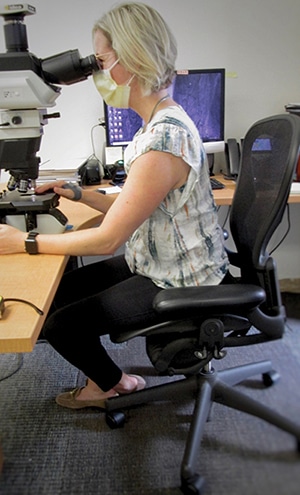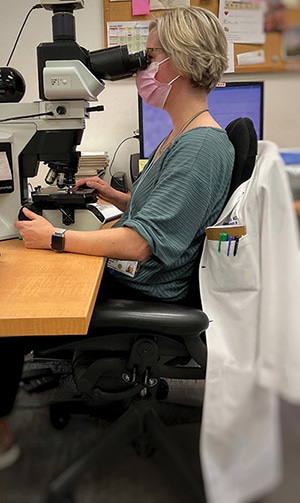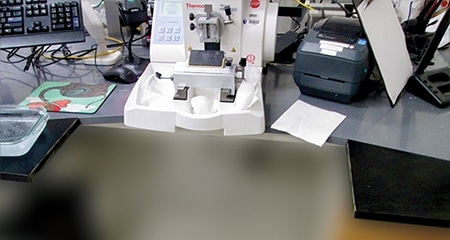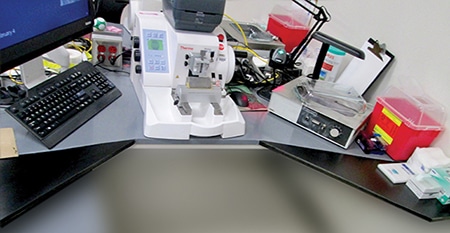Valerie Neff Newitt
February 2023—Workspace design seldom supports the tasks workers perform, and pain and productivity loss can be the outcomes. Eliminating the risks at the design stage is therefore the best approach. When that’s not possible, retrofitting to reduce or eliminate some (but not all) of the hazards is an option, though it’s difficult and can be costly, says Marissa Pentico, MS, OT/L, CPE, ergonomics coordinator in the Duke University Occupational and Environmental Safety Office.
Take laboratory bench heights, for example. The general principle is to design workspaces for 90 percent of the population, Pentico says, then make adjustments for the extremely short and tall. But for the lab workbench, “the easiest and best solution is to make the surface powered-height adjustable,” to accommodate not only workers of varying heights but also their various tasks.
One of Duke’s laboratories followed up on that suggestion. To cut costs, they asked the bench representative if it was possible to safely attach a standard office desk adjustable base to the bench. “It did work, and for less than $1,000 we were able to outfit a bench for powered adjustability,” Pentico says, adding that consulting with the bench and height-adjustable base representatives is key to ensuring stability and strength.

Dr. Sarah Bean at her microscope before the changes . . .
Many manually height-adjustable lab benches are available, she says, but they’re limited in terms of how high or low they can go. Standard heights are 36 to 37 inches, and she is aware of only one or two companies that offer more height options. “We need to start considering the heights people are working at and what they’re doing,” Pentico says. For a majority of the population, “over 40 inches is what we would recommend as a bench height for standing work tasks, and 29 to 30 inches for seated tasks—even lower for sole computer use.”
For standing work, as a general rule, bench height should be above elbow height for precision work (39–43 inches), just below elbow height for light work (34–37 inches), and four to six inches below elbow height for heavy work (28–35 inches).
There are benches that are considered height adjustable—they’re adjusted by pins—but the bench vendor is often called in to make the adjustments, Pentico says. “It needs to be easier than that. When a shorter employee is replaced by a taller employee during shift changes, they need to be able to make that adjustment easily.” When powered-height adjustment isn’t available, the only option, she says, is to identify a height that would accommodate a majority of the workers. “That’s really difficult, especially when you tie it in with microscope use, for example.”
Microscope and computer use require two separate heights. The keyboard and mouse have to be positioned lower—“at elbow height,” Pentico says. The microscope has to be higher. “We typically would recommend two different heights and positioning both so that the worker is able to pivot the chair from one to the other if the worker is sitting at an L-shaped workstation and is frequently alternating between both tasks.”

. . . and after the changes.
Eliminating or reducing twisting is important. A histotechnologist at a microtome with hot and cold baths placed on the sides would twist from in front of the microtome to reach the baths. A better workstation setup would keep the body aligned. In a case like this at Duke, “we worked with two designs,” Pentico says, where the bench vendor offered to retrofit two benches by adding pieces to their fronts. “We decided to place wings on either side of the lab worker. The goal was to have the water baths closer to the employee. One of the approaches was to change the angle of the wings to 90 degrees, the other to reduce it to a 45-degree angle, with the water baths placed on those wings.”
Some employees considered the first setup too enclosed, with too little ability to move, she says, and some chose the second option. Overall, the baths should be placed on the wings on either side, “so all they have to do is pivot their chair to access the bath and pivot their chair back to get to the microtome.” Also ensure there is clearance under the bench to enable the person to freely pivot.
What the employee looks at and/or reaches for or holds determines body position. With the microscope, for example, the height of the eyepiece determines the neck position. If too low, the neck will be bent. “If your elbows move away from your side when you manipulate the knobs on the microscope, then you’re reaching. You want to sit closer so you’re not having to lean forward and your neck is in a better position when using the eyepiece.” However, sitting too close to the adjustment knobs is also uncomfortable, she adds. “So you want to get close but you can’t get too close, and that’s what makes it hard.”
The same company that provided the wings for the microtome benches also provided them with a full benchtop with a cutout, so that it’s angled similarly, at 45 degrees. The benchtop was then placed on a powered height-adjustable base. “You can also put a microscope in the front so that the user is able to get in closer to the microscope and still have arm support.”


Microtome workstation designs. Top, the wings are at 90 degrees; bottom, 45 degrees.
 CAP TODAY Pathology/Laboratory Medicine/Laboratory Management
CAP TODAY Pathology/Laboratory Medicine/Laboratory Management
